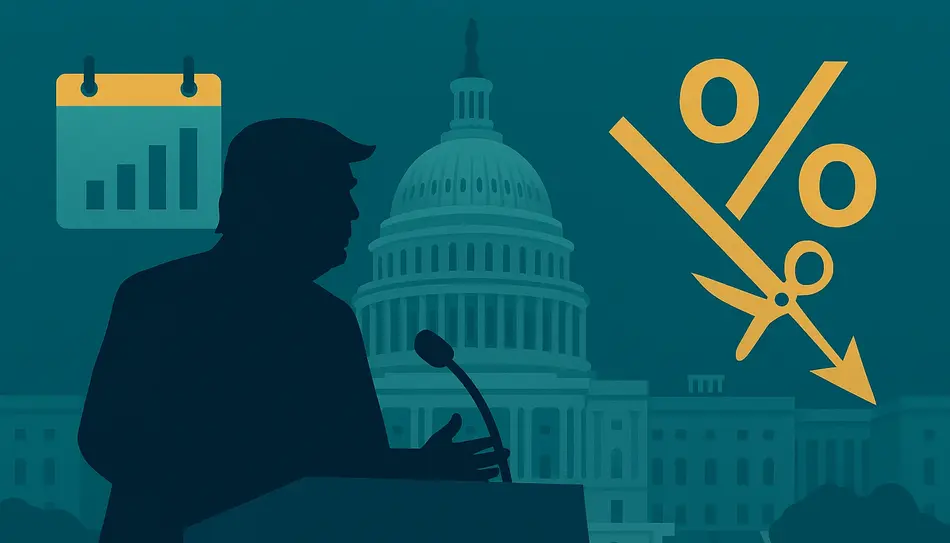A political storm over the U.S. labor market erupted this week when President Donald Trump sharply criticized the July jobs report, calling it “rigged” and firing the Bureau of Labor Statistics (BLS) commissioner. Yet in sharp contrast, Federal Reserve officials interpreted the same data as evidence that the economy needs interest rate cuts to avoid deeper job market weakness.
The diverging responses highlight a growing rift between political rhetoric and economic policymaking—one that could shape both the labor market and monetary policy in the months ahead.
The Numbers Behind the Dispute
The July employment report showed:
- 73,000 jobs added, well below economists’ expectations.
- Downward revisions to May and June data totaling 258,000 jobs.
- An unemployment rate rising to 4.2%, the highest in over two years.
- Wage growth slowing to 3.6% year-over-year, suggesting reduced labor market tightness.
To President Trump, the data represented a politically motivated distortion. He claimed the figures underestimated the economy’s strength and unfairly painted a negative picture. Within hours, BLS Commissioner Erika McEntarfer was dismissed, a move critics warn could undermine trust in official economic statistics.
The Fed’s Interpretation
For the Federal Reserve, however, the report underscored a different message: the U.S. job market is losing momentum and may need policy support.
Michelle Bowman, Vice Chair of the Fed, said the weak payroll numbers—combined with the revisions—signal “a softening in labor demand that warrants a recalibration of our policy stance.” She is calling for three rate cuts in 2025, starting as early as the September FOMC meeting.
Her view is shared by Governor Christopher Waller, who emphasized that the revisions make it clear that the earlier strength in the labor market was overstated.
Why the Fed Sees an Opportunity to Ease
- Weakening Labor Demand
The revisions and slower wage growth point to reduced competition for workers, which can help cool inflation without pushing the economy into a recession. - Room to Support Employment
With inflation trending closer to the Fed’s 2% target—excluding tariff-driven pressures—policymakers have more scope to focus on job preservation. - Avoiding a Hard Landing
Fed officials are keen to engineer a “soft landing,” easing rates before a mild slowdown tips into a full-blown recession.
Market Reactions
Financial markets reacted more to the Fed’s tone than to Trump’s criticism:
- Stock indexes climbed as traders priced in rate cuts.
- Bond yields fell, reflecting expectations of lower interest rates ahead.
- The U.S. dollar weakened slightly, as lower rates make the currency less attractive to investors.
The CME FedWatch Tool now places the probability of a September rate cut at over 90%.
Hire With Confidence in an Uncertain Economy
Post your job on WhatJobs and connect with top talent—no matter where interest rates go next.
Post a Job Now →Political Risks and Perceptions
Trump’s dismissal of the BLS commissioner is seen by some economists as a politicization of economic data, raising concerns about the independence of statistical agencies.
“The credibility of economic data is critical to policymaking and market stability,” said Diane Swonk, chief economist at KPMG. “Undermining that trust can have far-reaching consequences.”
The Fed, for its part, relies on multiple sources of labor data, including private payroll reports, job postings analysis, and household surveys, to confirm trends.
The Bigger Economic Picture
The jobs report is only one part of the Fed’s decision-making process. Other key factors include:
- Inflation Trends: Core inflation is moderating, though tariffs on imports are creating price pressures in some goods.
- Consumer Spending: Still resilient but showing early signs of slowing.
- Global Conditions: Trade tensions and weaker growth abroad could weigh on U.S. exports.
The combination of easing inflation and cooling labor demand is precisely the scenario in which the Fed historically begins to cut rates.
Sectoral Impacts of Weak Jobs Data
- Manufacturing: Hiring slowed sharply, partly due to tariff-related supply chain disruptions.
- Technology: Layoffs remain limited, but hiring freezes are spreading in software and hardware sectors.
- Retail & Hospitality: Seasonal hiring is subdued compared to last year, suggesting caution among employers.
- Healthcare: One of the few sectors still adding jobs steadily, driven by demographic demand.
Possible Fed Policy Path
- September 2025: 0.25% rate cut highly likely.
- November & December 2025: Potential for one or two more cuts if job growth remains soft.
- 2026 Outlook: Fed could pause to assess inflation and employment response before deciding on further easing.
FAQ: Jobs Data, Politics, and Policy
Q: Why did Trump call the report ‘rigged’?
He believes the data undercounts job creation and portrays the economy as weaker than it is, potentially for political reasons.
Q: How does the Fed use jobs data?
It’s a key input for setting interest rates, helping determine whether policy should tighten, loosen, or stay the same.
Q: What’s the risk of cutting rates too soon?
It could reignite inflation if demand rebounds faster than supply.
Q: Could the Fed ignore BLS data if it’s politicized?
The Fed cross-references multiple independent data sources, but official statistics remain central to policymaking.
The Bottom Line
While President Trump’s criticism of the July jobs report has amplified political tensions around economic data, Federal Reserve officials are reading the same numbers as a signal to act. With inflation moderating and the labor market losing steam, the Fed appears poised to deliver its first rate cut of 2025 next month—setting the stage for what could be a pivotal shift in U.S. monetary policy.




